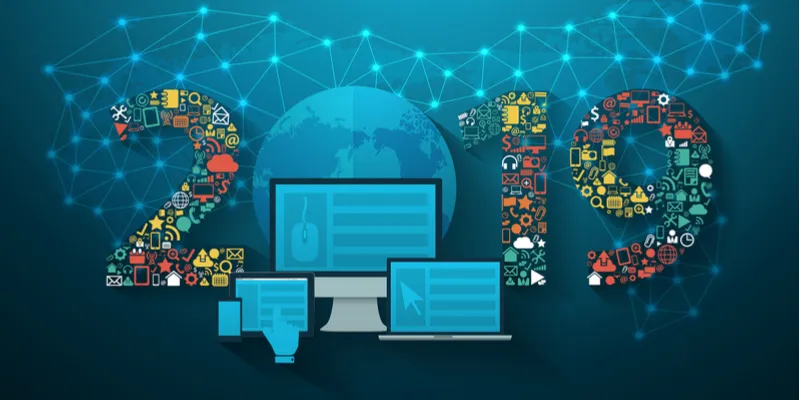Technology trends that will outline the IT industry in 2019
With innovation knocking the doors of every industry, technology has now become a basic need for survival of the business and the society at large. We heard about Artificial Intelligence, Machine Learning, and Deep Learning in 2018. Be prepared to see a convergence of them across different applications to create an unimagined future for humans.

Every industry will look at innovative ways to use technology to further improve customer experience, reduce the time to market significantly and improve operational efficiency thereby reducing operating costs.
Here are a few trends which will rule the industrial growth and advancements in 2019. While there are varied emerging trends ruling the market today, we are going to discuss the most awaited trends which will gain momentum in 2019.
API economy and microservices
Most of the companies are in the constant lookout for means to accelerate time to production, reduce cost and improve efficiency. On one hand the new age companies are building application cloud native, on the other hand, traditional companies are looking to accelerate digital transformation. In either case, modernization is the need of the hour to gain more market share and remain nimble in the competition. The ways new applications will be built and deployed in 2019 will be through API, Microservices and Containerization. These approaches will make applications more scalable and reduce deployment time.
Microservices architecture provides a comprehensive suite of modular services and breaks down monolithic applications into self-dependent services. In the endeavour to become agile, companies are expected to increase investments in microservices.
APIs allow applications to talk to each other in a secure manner. Open APIs allow enterprises to talk to FinTechs and other service providers and this will foster innovation at a higher level. In 2019, APIs will play a crucial role in European geography where regulatory measures like Payment Services Directive (PSD2) and Open Banking would mean financial institutions will increase investments on these technology trends for providing secured accesses to third parties.
Application Programming Interfaces (API) and microservices are expected to coexist with traditional applications but gradually replace them to create an integrated experience and increase interactions of every business with the world.
Artificial Intelligence coming of age
AI-based digital assistance like Alexa, Siri, or Google Assistant have increasingly grown their reach and real-time self-service options are becoming ubiquitous. While there is still a lot of hype around AI, in 2019 AI is going to be more mainstream across different segments of business and integrated with internal systems of industry-specific requirements. AI will be used within enterprises from operational to more strategic work tasks. This will be possible through advancements in Deep Learning and better usage of Neural Networks. The amount of data available to train models has increased significantly and therefore will help Deep Learning. AutoML (automated Machine Learning) algorithms will help software developers to solve complex problems without the need of creating complex models and workflow. The interoperability of neural networks has been a challenge and to fix this AWS, Facebook, and Microsoft has set up Open Neural Network Exchange (ONNX) some time back which will help reuse of trained neural networks across different machine learning frameworks. This opensource AI ML possibly will gain momentum in the next year. Apart from the software advancements, AI optimized chips build specifically AI tasks also help AI take off to a new trajectory.
Cybersecurity and Data Security
As data will continue creating new opportunities for enterprises, privacy risks and regulatory compliances will be at the forefront. To secure and monetize on data, new automated preventive methods will rule the Information security space.
Cybersecurity is believed to become more intelligence obsessed in 2019. Both small and large businesses will have to redefine their approaches to overcome data security challenges and protect their volumes of sensitive data by early prediction and preparedness. Organizations will have to migrate their important data/workflows on cloud-based services and utilize the benefits of AI/ML programs to help identify and protect the servers from hackers thus preventing security breaches and cyber-attacks.
Automation
Inevitably companies will have to replace traditional approaches with new automation systems which are served up as SaaS. Work-flows will be revamped with automation to help simplify the process of managing large volumes of data and tasks for enterprises on a daily and even hourly basis. This can further help companies eliminate silos and improve day-to-day processes to increase overall efficiency. From gadgets at home to a massive scale industrial application, automation will become a key focus of technological change. The two types of automation which the businesses are adopting are RPA and BPA. Business Process Automation focuses on restructuring the workflows and core operations of a business by making day-to-day tasks more effective. Robotic Process Automation uses software to amplify the performance of existing processes and replaces human tasks with software.
Increase in Cloud Adoption and Cloud Computing
The adoption of cloud computing in the businesses has been growing rapidly. The spending on the cloud is expected to grow at more than six times the rate of general IT spending this year. Few key trends that can be foreseen are rapid enterprise cloud adoption, reduced concerns over cloud providers’ security, increasing the complexity of cloud deployments, and the increase in as-a-service deployment thinking. The Hybrid Cloud model will offer a transition solution to the enterprises that mixes the existing on-premises infrastructure with public cloud and private cloud services. This will help in creating a way where companies can transition to the cloud at their own pace while being flexible and efficient.
Serverless cloud architecture is the fastest growing model and going to gain momentum in 2019. Serverless architecture significantly lowers the running and operational costs
Due to features like pay-per-use, high resiliency, ability to scale up/down based on usage, self-service etc. cloud service providers such as Amazon Web Services (AWS), Microsoft Azure, and Google Cloud appeal to many organizations. All these features are expected to benefit and lead cloud usage to a much lower IT costs, better service quality compared with traditional IT offerings and faster time-to-market.
Connected to microservice and serverless architecture, we will see Containerization become even more popular. Containerization helps the software development and operations teams in abstracting the applications and the platform into an easily manageable container which allows building and deploying applications faster. Organizations are seeing clear benefits through containerization and will increasingly use tools like Google’s Kubernetes, Docker's Swarm, Apache's Mesos, and others for containerization in 2019.
(Disclaimer: The views and opinions expressed in this article are those of the author and do not necessarily reflect the views of YourStory.)







